Media | Articles
8 throwbacks to when compact pickups were truly compact
If today’s “compact” pickups seem like yesterday’s full-size pickups, you’re not crazy. A 2020 Ford Ranger is 210 inches long, and a Toyota Tacoma, nose to tail, is 212; those figures are comparable to a 1979 Ford F-Series regular cab pickup. Even in the ’70s, that seemed like more truck than some people needed. The Japanese pioneered the idea of smaller pickups, mostly because they designed trucks for their home market, where space came at a premium. However, as consumers embraced small cars in 1960s and ’70s, they also embraced small pickups.
Here are 8 throwbacks to an era when compact pickups really were compact.
1959 Datsun 1000 Pickup
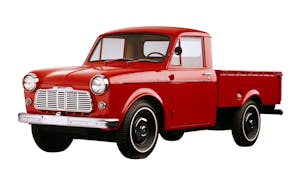
Credit Nissan for selling the first compact Japanese pickup in America under the Datsun name. Nissan entered the American market with the 1000 sedan and rear-wheel-drive Datsun 1000 pickup. Heavily influenced by the British-made Austins, the truck’s minuscule 1.0-liter four-banger generated 37 hp, enough to haul a whopping 500 pounds. The following year, Nissan upgraded the pickup with a 48-hp 1.2-liter engine and renamed it the 1200.
As you might imagine, the pickup was slow, as were sales. The 1200 suffered from weak brakes and an engine designed for mild Japanese winters. The problem? The batteries were too small, which made them difficult to start on frigid Midwest mornings. Despite its weak points, however, the 1959 Datsun 1000 established a market segment that would reach its peak two decades later.
Marketplace
Buy and sell classics with confidence
1969 Toyota Hilux

Though the Hilux first hit Japanese streets in March of 1968, Toyota didn’t introduce its first pickup to the American market until June, 1969. Until then, Toyota had been marketing Briska pickups developed and manufactured by Hino Motors. Like its predecessors, Hilux was manufactured by Hino, but Toyota handled the entire development process independently.
The Hilux was powered by an 84-hp, 1.5-liter four-cylinder engine and a four-speed column-mounted manual also used on the Japanese-market ToyoAce cabover truck. The Hilux featured a double-wishbone/coil-spring front suspension, a rigid-axle/leaf-spring rear setup, and a six-foot cargo bed. Payload capacity was rated at 2200 pounds.
1972 Chevrolet LUV pickup

Observing the growing success of diminutive Japanese pickups, Chevrolet fielded its own for 1972, importing the Isuzu Faster and rebadging it as the Chevrolet Light Utility Vehicle, or LUV. A 75-hp, 1.8-liter, overhead-cam four-cylinder and a four-speed manual transmission came standard. An automatic transmission arrived for 1976, and a longer bed and four-wheel drive for 1979. The LUV boasted a 1400-pound payload with its six-foot bed. Following the pattern set by the other trucklets on this list, the rear-drive LUV had an independent front suspension and a solid rear axle. In 1982, Chevy replaced the Luv with the midsize S-10.
1972 Ford Courier

Ford jumped on the compact pickup bandwagon with the Courier, which was essentially a Mazda Proceed styled to resemble an F-Series pickup that had been left in the dryer too long. The Courier featured a 1.8-liter overhead-cam engine that generated 74 hp and shifted via a four-speed manual. A five-speed was offered in 1976; a three-speed automatic was optional. The Courier boasted a 74.5-inch bed and a 1400-pound payload.
Ford replaced the Courier with the Dearborn-designed Ford Ranger in 1982. Ironically, Mazda would market a badge-engineered Ford Ranger from 1994–2000.
1978 Subaru BRAT

This is the oddball of the bunch—the front-wheel-drive 1978 Subaru Bi-drive Recreational All-terrain Transporter, or BRAT. What makes this trucklet odd isn’t its small size, but the two rear-facing seats in its pickup bed, which Subaru bolted in to avoid the 25 percent tariff on imported pickup trucks. Thanks to the hard plastic seats in its bed, the BRAT qualified as a passenger vehicle, not a pickup.
Plastic seats aside, the BRAT borrowed its mechanical underpinnings from Subaru’s Leone station wagon: a 67-hp 1.6-liter flat-four mated either to a four-speed manual or to a three-speed automatic transmission. The quirky truck featured part-time four-wheel drive but could haul a mere 350 pounds. The BRAT endured into a second generation, in which it gained a turbocharged engine and even T-tops. Subaru imported BRATS stateside through 1987 and they remained in production overseas through 1994.
1979 Dodge D-50 and Plymouth Arrow
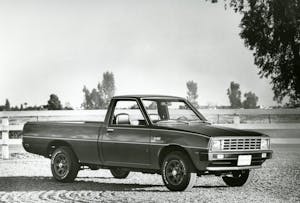
Don’t let the domestic name fool you; the 1979 Dodge D-50 and Plymouth Arrow pickups were, in reality, rebadged Mitsubishi Fortes with 6.5-foot beds and maximum payloads of 1400 pounds. The base models got a 93-hp 2.0-liter four and a four-speed manual; Sport models boasted a more powerful 105-hp, 2.6-liter four-pot paired with a five-speed (a three-speed automatic was optional). The Plymouth Arrow survived until 1982, while the Ram 50 was built through 1986, when it was replaced by an all-new model.
1980 Volkswagen Pickup Truck

VW showed up late to the compact pickup party, introducing a Rabbit-based pickup for 1980. The VW Pickup—yes, that was its official name—rolled off the assembly line at Volkswagen’s Westmoreland factory in Pennsylvania, and VW made no bones about its Rabbit underpinnings. Under the pickup’s hood sat the Rabbit’s 78-hp 1.6-liter four-cylinder; if you opted for the 1.5-liter diesel (similarly cribbed from the Rabbit) you made do with only 48 hp. Both powerplants mated to a four-speed manual transmission, although a five-speed manual was available with either; on the 1.6-liter gas engine, a three-speed automatic transmission was optional.
The independent front suspension carried over unchanged from the Rabbit, but thankfully VW outfitted the Pickup with a more robust setup in the rear. Fully loaded, the truck could tote 1100 pounds. Though it was initially popular, plunging demand led to the Pickup’s demise by 1983.
1982 Dodge Rampage/Plymouth Scamp
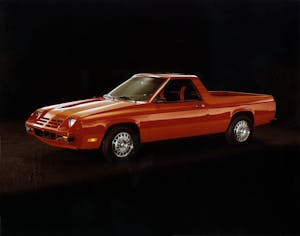
Beginning in 1982, Chrysler Corporation fielded a Dodge Rampage pickup based on its front-wheel-drive L-body platform, which also underpinned the Dodge Omni/024/Charger and Plymouth Horizon/ TC3. The Rampage represented the first front-wheel-drive pickup offered by an American automaker.
Built using a longer wheelbase than its four-door relatives, the Rampage could haul up to 1000 pounds. Power came from Chrysler’s 84-hp, 2.2-liter four-banger and was channeled through a four-speed manual; a three-speed automatic or five-speed manual were optional. The Rampage survived until 1984 only to be resurrected in 1986 when Dodge rolled out the California Shelby Rampage. The reincarnated, hotted-up trucklet boasted a 99-hp version of the 2.2-liter motor that sent power through a four-speed manual and rumbled through performance exhaust. Just 218 were made.
Which is your favorite compact throwback?






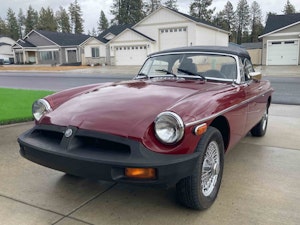
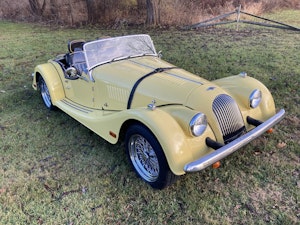






I had a 1974 Mazda pickup with a rotary engine and 4 speed manual. Tailgate had “Rotary Power” on it.